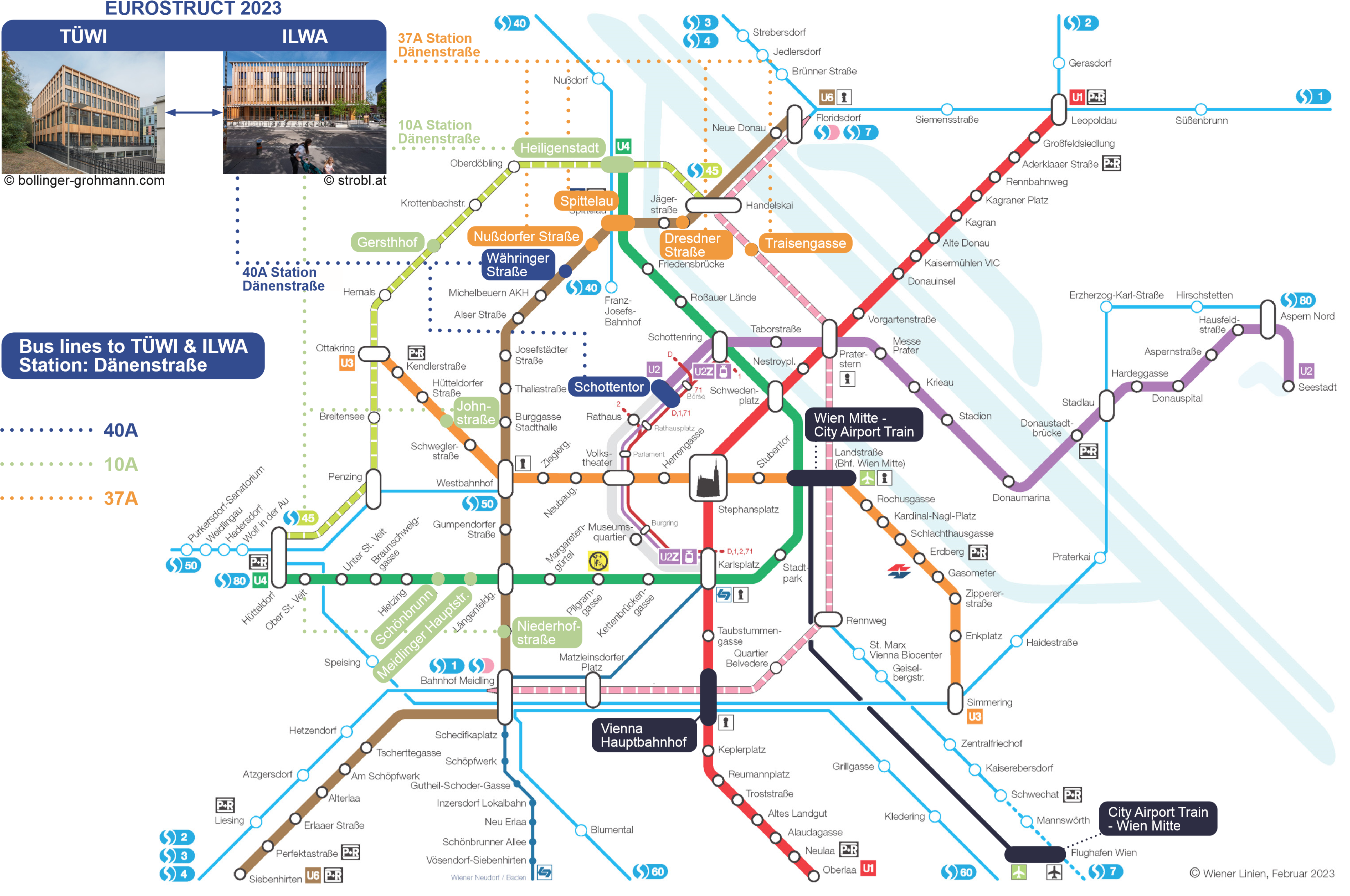- Introduction
- Organization
- Key Dates
- Venue
- Mini-Symposia
- Special EuroStruct Topics
- Call for abstracts
- Authors Information
- Paper Submission
- Templates
- Awards
- Program
- Registration
- Presentation Submission
- Technical Visits
- Accommodation
- Transportation & Local Info
- Patronages
- Exhibitors
- Sponsors
- Contact
- Photos & Videos
- Proceedings
Transportation & Local Info
Vienna Internation Airport (VIE)
The main airport of Vienna, the capital of Austria, is situated in Schwechat, approximately 18 km (11 mi) southeast of central Vienna and 57 km (35 mi) west of Bratislava, the capital of Slovakia. Referred to as the Wien-Schwechat Airport it stands as the largest airport in the country.
Austrian Airlines operates primarily from this hub, while low-cost carriers Notably, the airport is equipped to handle wide-body aircraft, including the Airbus A380. With an extensive network of European connections and offering long-haul flights to destinations in Asia, North America, and Africa, it serves as a crucial international gateway for air travel.
With two Airport Service counters on the departures level (Terminal 1, Terminal 3) and one Airport Service counter in the arrivals hall, airport staff is available to provide passengers with
advice and assistance.
Facilities available at the airports include tourist information offices and car rental services.
You can also contact the Vienna International Airport by e-mail for service inquiries.
Public Transport
Vienna has a well-developed public transport network. Buses, trains, trams, and underground lines will take you almost anywhere in the city in no time at all. Vienna public transport Wiener Linien operates five underground lines, 29 tram and 127 bus lines, of which 24 are night lines.
Night lines only operate between 0.30 am and 5 am. On weekends and public holidays, the Vienna underground remains at the service of its passengers all night. A single ticket costs € 2.40.
Where to buy a ticket
- ticket machines at most underground stations
- points of advance sale (German)
- tobacconists also sell tickets
- on board the tram at an increased rate of € 2.60 per ticket
- Buy tickets online: Wiener Linien Online Shop
How to validate your ticket
Tickets must be validated before boarding. To validate your ticket stamp the ticket at the blue machines located at the entrance of underground stations as well as on buses and trams. Tickets
bought directly from the tram or bus driver are automatically validated and need not be stamped again.
How to get to Ilse-Wallentin building and TÜWI at BOKU
The best way to reach the BOKU site area by public transport is with the following lines:
direction out of town:
- Bus 10A in the direction of Niederhofstraße to the Dänenstraße station
- Bus 37A in the direction of Dänenstraße to the station Dänenstraße
- Bus 40A direction Döblinger Friedhof to the station Dänenstraße or Borkowskigasse
direction towards the city center:
- Bus 10A direction Bahnhof Heiligenstadt to station Dänenstraße
- Bus 37A direction Engerthstraße/Traisengasse to station Dänenstraße
- Bus 40A direction Schottentor to station Dänenstraße or Borkowskigasse
Also, the Suburban line S45 direction Handelskai or Hütteldorf to station Gersthof is a good way to reach BOKU.
The Bus line 10A is connected to the local suburban line (Bhf. Heiligenstadt, Gersthof) and the underground lines U3 (Johnstraße), U4 (Schönbrunn, Meildlinger Hauptsraße), and U6 (Niederhofstraße)
The Bus line 40A is connected to underground line U6 (Währingerstraße Volksoper) and finishes at the city center (Vienna Schottentor/Börse).
The Bus line 37A is connected to underground lines U6 (Dresdner Straße, Spittelau, Nußdorfer Straße), U4 (Spittelau), and the local suburban line (Traisengasse, Spittelau).
Local Info Vienna
Weather
Vienna in September has temperatures ranging from a minimum of 12°C to a maximum of 21°C.
It is a bit milder in September so it is a good idea to bring something to cover up with.
In Vienna, you can expect 3 to 8 rainy days in September. It is a good idea to bring your umbrella so that you are not exposed to bad weather.
Currency
The currency in Austria is the Euro. You can exchange currency in banks, exchange offices, airports, and hotels. For daily exchange rates, please visit the website of the Österreichische Nationalbank.
If you do not want to exchange your currency, you can use credit or debit cards. MasterCard and Visa are widely accepted by most merchants. A little cash is however recommended for small expenses. Coins are available in €2 and €1. Paper notes are available in the same denominations as the US dollar up to €500 (€5, €10, €20, €50, €100, €200, €500).
Time Zone
Austria in september observes the Central European Summer Time (CEST, UTC+2), lasting from the last Sunday in March to the last Sunday in October and one hour ahead the Central European Time (CET, UTC+1).
Electricity
Electricity in Austria is 230 volts, 50 cycles alternating current (AC).
Austrian power plugs sockets are designed to accept round pins and the following plug types: type F, type C, and type E.

